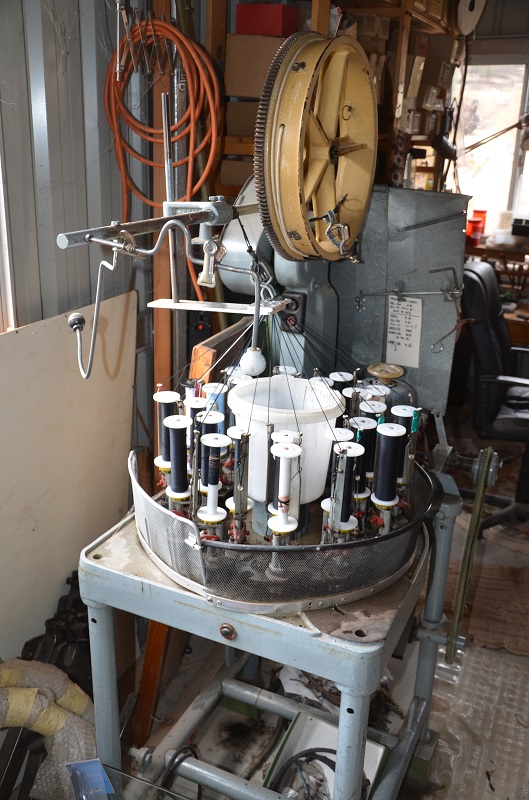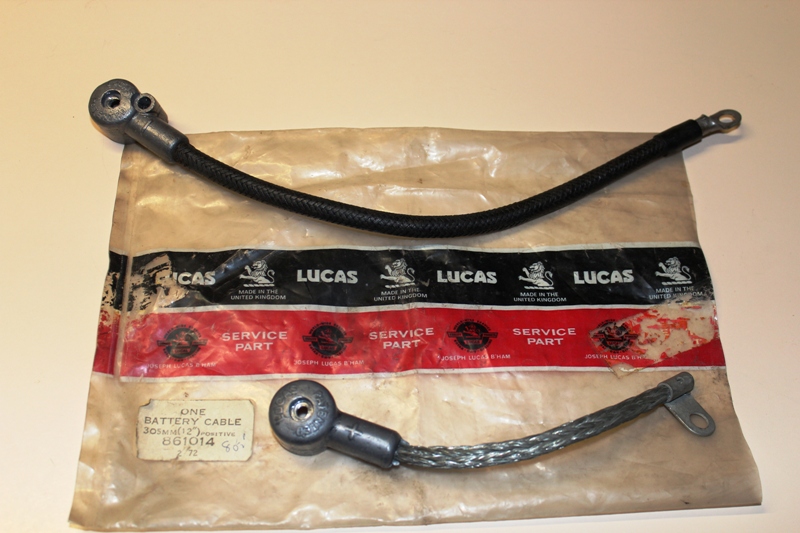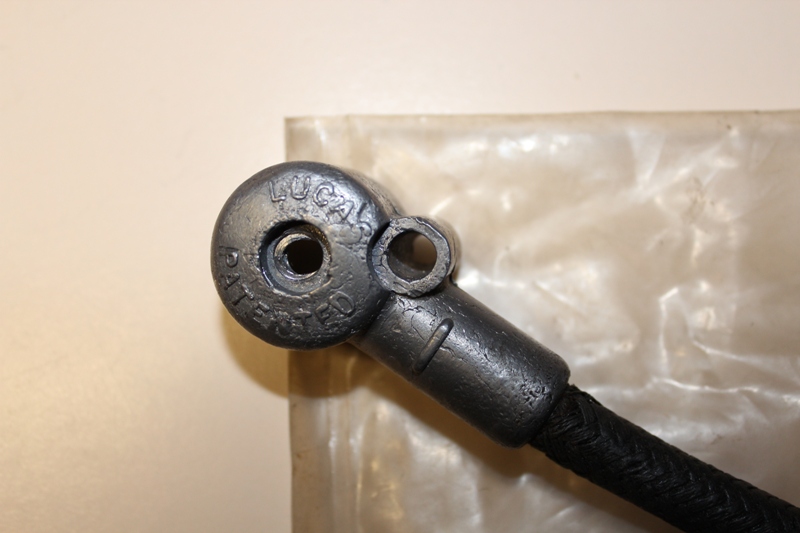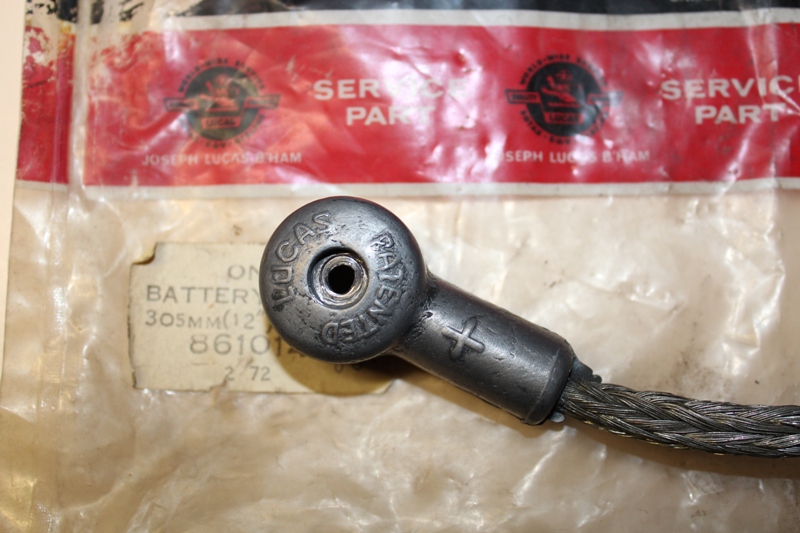These pages contain detailed information about the wiring looms used in the MGTD and MGTF. The first section, from Barrie Jones, contains information about the wiring color codes used inside the harnesses. The second section, from Bruce Sharman of Bygone Spares and Restorations, describes the loom outer coverings or sheath in great detail. The last section deals with battery cables with information provided by Rob Grantham, Australia.
A guide to the wiring colour codes of the MG sports car by Barrie Jones. © 2009 by Barrie Jones
The automotive wiring colour code that we know today was invented around
1936. I believe the company that invented and maintained it was Ripaults, not
Lucas. Ripaults Cables Ltd is a long-established manufacturer of automotive
cable and wiring looms in the UK.
The Ripaults colour code quickly
became the de facto standard in the UK. Each colour was denoted by a unique
letter, and some letters were reserved for other purposes. MG did follow the
colour code, but unfortunately they did not use the letters on their wiring
diagrams until 1962, staying with an earlier system where the wiring diagram
used numbers and a cross-reference table was required.
Different codes
were followed in other countries, and many cars sold in the UK used the German
code, particularly VW. Ford cars could have either UK or German looms,
depending on where they were built.
| Reserved letters |
| A = Ammeter |
| D = Dynamo |
| E = Earth |
| F = Field coils |
| L = Light or Lights (as in head light, and also light green!) |
| Colours |
| B = Black |
| R = Red |
| O = Orange |
| W = White |
| N = browN |
| U = blUe |
| G = Green |
| P = Purple |
| Y = Yellow |
The only significant change to the colour code was around 1955, when the primary colour Yellow was changed to Brown. Secondary colours were not changed at that time, so Yellow with a Red stripe became Brown with a Red stripe, etc. The special cases were:
MG continued to use Yellow on the TF and all the MGAs, only changing to Brown when they introduced the MGB in 1962.
At some time, the primary colour of Purple was introduced for those wires that were fused (A1-A2) and permanently live (e.g. the horn circuit). The timing of this change is unclear, because some TDs used the new colour code, although the TF and the MGA did not.
Since then, new colours have been added to the system, notably Light Green (LG), Slate grey (S), Pink (K) and Orange (O). There is one light green wire in the TF loom. I assume that Ripaults chose S for Slate grey because they had already used G, R, E and Y.
The first table (following) shows the meaning of the primary colour. For example, all white wires are part of the ignition circuit, they are not fused, and they are switched via the ignition switch
| Primary Colour | Code | Use | Fused | Switched |
|---|---|---|---|---|
| White | W | A3 - Ignition & Fuel pump | no | Ignition |
| Black | B | Earth | no | no |
| Brown | N | Charging circuit | no | no |
| Yellow | Y | Charging circuit | no | no |
| Blue | U | Headlights | no | Headlight switch |
| Red | R | Sidelights | no | Sidelight switch |
| Green | G | A4 - brake lights, wiper motor & heater | A3-A4 | Ignition |
| Purple | P | A2 - horns & courtesy lights | A1-A2 | no |
* some brown wires are fused prior to the introduction of purple
The second table (following) shows most of the wires in the TF loom, including those with a stripe. For example, the wire between the distributor and the coil should be white with a black stripe, coded WB.
| Primary Colour | Colour Code | Lucas Lettering | Use |
|---|---|---|---|
| Black | B | E | Earth |
| Brown | N | Battery to ammeter | |
| Battery to fuse box A1 | |||
| NU | A1 | Light switch to regulator A1 | |
| NW | A | Ammeter to regulator A | |
| NG | A2 | Fuse box A2 to horns | |
| NB | Horns to horn button | ||
| Yellow | Y | D | Dynamo D to regulator D Ignition warning light to regulator D |
| YG | F | Dynamo F to regulator F | |
| Blue | B | S2 | Light switch to dip switch |
| BW | Dip switch to headlamp main beam | ||
| Dip switch to headlamp warning light | |||
| BR | Dip switch to headlamp dipped beam | ||
| Red | R | S1 | Light switch to sidelights |
| Light switch to number plate light | |||
| Light switch to panel light switch | |||
| Light switch to fog light switch | |||
| RW | Panel light switch to panel lights | ||
| White | W | A3 | Ignition switch to coil SW |
| Ignition switch to fuse box A3 | |||
| Ignition switch to ignition warning light | |||
| WP * | Rear Nearside turn indicator & brake light | ||
| WN * | Rear Offside turn indicator & brake light | ||
| WB | CB | Coil to distributor contact breaker | |
| Green | G | A4 | Fuse box A4 to turn indicator switch |
| Fuse box A4 to turn indicator relay | |||
| Fuse box A4 to wiper motor switch | |||
| Fuse box A4 to petrol warning light | |||
| Fuse box A4 to accessories (e g heater) | |||
| Fuse box A4 to brake light switch | |||
| GP | Brake light switch to turn indicator relay | ||
| GB | Petrol tank sender to petrol warning light | ||
| GR | Front Nearside turn indicator | ||
| GW | Front Offside turn indicator |
* I know they are white, but logically they should have been green
| Primary Colour | Colour Code | Lucas Lettering | Use |
|---|---|---|---|
| Black | B | E | Earth |
| Brown | N | Battery to ammeter | |
| A1 | Battery to separate fuse box A1 | ||
| NU | A1 | Light switch to regulator A1 | |
| NW | A | Ammeter to regulator A | |
| NG * | A2 | Fuse box A2 to horns | |
| NB * | Horns to horn button | ||
| Yellow | Y | D | Dynamo D to regulator
D Ignition warning light to regulator D |
| YG | F | Dynamo F to regulator F | |
| Blue | B | S2 | Light switch to dip switch |
| BW | Dip switch to headlamp main
beam Dip switch to headlamp warning light |
||
| BR | Dip switch to headlamp dipped beam | ||
| Red | R | S1 | Light switch to sidelights |
| Light switch to number plate light | |||
| Light switch to panel light switch | |||
| Light switch to fog light switch | |||
| RW | Panel light switch to panel lights | ||
| White | W | A3 | Ignition switch to coil SW |
| Ignition switch to fuse box A3 | |||
| Ignition switch to ignition warning light | |||
| WB | CB | Coil to distributor contact breaker | |
| Green | G | A4 | Fuse box A4 to turn indicator switch |
| Fuse box A4 to turn indicator relay | |||
| Fuse box A4 to wiper motor switch | |||
| Fuse box A4 to petrol warning light | |||
| Fuse box A4 to accessories (e g heater) | |||
| Fuse box A4 to brake light switch | |||
| GP | Brake light switch to brake lights | ||
| GB | Petrol tank sender to petrol warning light | ||
| GR | Front nearside turn indicator | ||
| GW | Front offside turn indicator | ||
| Purple * | P | A2 | Fuse box A2 to horns |
| PB | Horns to horn button |
* Some TD looms used purple, most used brown
This section is a compilation of information and comments to me from Bruce Sharman of Bygone Spares and Restorations in Western Australia, which manufactures custom harnesses to your car specifically. © 2013 by Bruce Sharman
I have original samples of wiring harnesses in my “museum” for want of a better description. It appears from our samples and research that Vic Longden carried out that most Lucas harnesses started out black. As an electrical change was made in the circuitry, then a coloured trace was added to the outer braid. When another change occurred another trace was added. We believe that this aided the car manufacturer (for example MG) identify the harnesses and ensure they were fitted correctly to the correct model. This was not necessarily at “official” model change, but could occur midway through a production run or could be for changes in the circuitry for export models.
I have most of the colours from M types through to the last of the MGBs. This can be quite complicated as some of the cars with several components to the harness, could have different colours in each part of the harness, depending if a change occurred to that particular section. Also as already mentioned the colours change midway through a production run of a particular model, so a lot of my information also relates back to a chassis number rather than model type. Then to add to this complication during the fifties some cars had a combination of Khaki and black. Our theory is this may have been due to cotton or dye shortages post war. Then throw into this mix the fact that the earlier cars (up to late 40s ish) are braided with 4 strand thick cotton as opposed to the later cars which have 6 strand cotton braiding.
 It is all based on the braiding machine. This machine has 24 bobbins. 12 with cotton running to the RH side of the braid
and 12 running to the LH side of the braid. It works like a maypole, with the bobbins going around and under over each other,
just like dancers round a maypole. If I am using this / symbol it means the trace is running to the RH side of the braid,
( so looking from above this dancer is running clockwise (CW), when using this \ the trace is running to the LH side of
braid and the dancer would be running anti clockwise (ACW). When using this X symbol there is one dancer running CW and one
running ACW When using this //\ symbol there are 2 dancer next to each other running CW and one running ACW When
using / black / black /. There are 3 dancers running CW with a black dancer in between each.
It is all based on the braiding machine. This machine has 24 bobbins. 12 with cotton running to the RH side of the braid
and 12 running to the LH side of the braid. It works like a maypole, with the bobbins going around and under over each other,
just like dancers round a maypole. If I am using this / symbol it means the trace is running to the RH side of the braid,
( so looking from above this dancer is running clockwise (CW), when using this \ the trace is running to the LH side of
braid and the dancer would be running anti clockwise (ACW). When using this X symbol there is one dancer running CW and one
running ACW When using this //\ symbol there are 2 dancer next to each other running CW and one running ACW When
using / black / black /. There are 3 dancers running CW with a black dancer in between each.
The norm then is to run the braid from each sub branch end to the main branch (using a tree as an analogy). Once this is completed then run the braid down each main branch to the trunk. Once all are completed then we start at the thickest end (usually dash end) and braid down the main trunk. Sorry if this is confusing, but it is the only way I can explain the direction the trace runs down the harness without seeing the machine in operation. Again distance between traces varies because of the machine. If there are only a few wires, distance is generally about ¾". Where there is a big thick bunch of wires, i.e. bulkhead area it can increase to about 1" spacing.
Short video of Bruce's braiding machine in action.
The following tables describes the harness during the production of the MGTD.
On the MGTD harness all are six strand, both body and tracers. All TD harnesses were black. At one time it was thought that some TD's had brown looms but it is now believed the dies were variable and the brown harnesses were just faded black harnesses.
| Car Number Range | Harness Type | Drive | Tracer Colour | Direction | Comment |
|---|---|---|---|---|---|
| 0251 - 8141 with RF95 regulator | Main | Right | Yellow | / | |
| 8142 - 19299 with RB106 regulator | Main | Right | Yellow | / | At one time thought to be a white tracer but now believed to be yellow |
| 9300 to end | Main | Right | Yellow | / | |
| 0251 - 8141 with RF95 regulator | Main | Left | Yellow | X | Crossed yellow trace tracer |
| 8142 - 19299 | Main | Left | Yellow | //\ | |
| 19300 to end | Main | Left | Yellow | // | |
| 0251 - 19299 | Tail | Both | Yellow | / | |
| 19300 - end | Tail | Both | Yellow | \ | Trace now goes in opposite direction |
| 0251 -18882 | Panel | Both | Red | / | Single ½ red trace |
| 18883 - end | Panel | Both | Red | X | Single ½ red trace |
Panel harnesses are 6 strand black and 3 strand red.
This is for the main harness no details for the tail so I assume it is the same as RH drive cars.
The following table describes the harness during the production of the MGTF. All looms are 6 strand cotton.
| Car Number Range | Harness Type | Drive | Colours | Direction | Comment |
|---|---|---|---|---|---|
| TF501- TF1509 with toolbox pump | Main | orange, black, 3 brown, 2 black, 2 brown, black, 2 brown in this order Then going in the opposite direction 3 black, 4 brown, 3 black, 2 brown, in this order |
\
/ |
This gives a total of 24 cottons of 6 strand each so as with all harnesses they have to be made on a 24 bobbin machine. Some are made on 16 and less bobbin machines and are not correct | |
| TF1510 - end with wheel arch pump | Main | orange, black, black, brown with the rest of bobbins being black | //// | ||
| Chassis TF501 - end | Panel | orange | / | single tracer | |
| Chassis TF501 - end | Headlamp and Parking Lamp | orange | / | single tracer |
Various wires on the MGTD/TF harnesses received special protective coverings beyond the loom braiding. These were either from a wear perspective or to keep the environment or automotive fluids from damaging the wires and causing shorts. Many of these covers would need to be applied before the wiring connectors are added, especially in the case of the larger round connectors. Where available you can select the hyperlink on the location text to see an picture of the protective covering.
Not all cars had all of this protective tubing. I will use the ± character to indicate an item that may or may not have been in place for your car.
| Location | Material | Dimensions | Comment |
|---|---|---|---|
| Over the coil to distributor white/black wire.± | Rubber | 3/16" x 9" | On NA cars we see rubber on the ends of the cable (~1") |
| Over the fog light wire | Rubber | 3/16" x 23" | The fog lamp wire was terminated with a single bullet connector |
| Over the number plate wires | Rubber | 3/8" x12" | Some cars have a 9mm PVC cover instead of rubber |
| Over brown wire at the starter switch/solenoid on earlier cars | Rubber | 1/4" x 6" | |
| Later cars had a cover over the 2 brown wires at the starter switch/solenoid | PVC | 9mm x 8" | |
| Behind pedal box and master cylinder | PVC | 18mm x 18" | |
| Over LH rear± | PVC | 12mm x 24" | |
| Over RH rear± | PVC | 12mm x 24" | |
| Over each park light cable± | PVC | 4mm x 13" | If indicator cabling is included all these will need increasing in diameter |
| Over beginning of tail branch± | PVC | 12mm x 8" |
| Location | Material | Dimensions | Comment |
|---|---|---|---|
| Below regulator past fuse | PVC | 18mm x 2" | |
| Over regulator | PVC | 16mm x 2 ½" | |
| Past relay to fuse | PVC | 16mm x 2 ½" | |
| Coil to Relay | PVC | 12mm x 2 ½" | |
| Horns | PVC | 14mm x 35" | |
| Horns | PVC | 12mm x 17" | |
| Behind pedal box and master cylinder | PVC | 18mm x 24" | |
| Over Left Hand Rear | PVC | 12mm x 24" | |
| Over Right Hand Rear | PVC | 12mm x 20" | |
| Number Plate Cable± | PVC | 10mm x 18" | |
| Over coil to distributor white black± | Rubber | 3/16" x 7" | On NA cars we see rubber on the ends of the cable (~1") |
| Right headlamp wire near fuel line connector | PVC | 14mm x 3" | |
| Over each park light cable± | PVC | 10mm x 15" | Note on picture spiral protector is not original |
The following images are new old stock (NOS) MGTD/TF battery cables with their original packaging.



Above battery cable photo's courtesy of Rob Grantham, Australia.
Home | History | Details | Myths, Tips and FAQs | Literature | Entertainment | Gallery | Links | Map
| © 1999 - 2024 by Christopher C. Couper | Page last updated on March 2, 2019 |